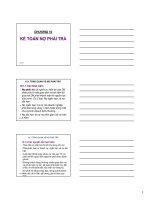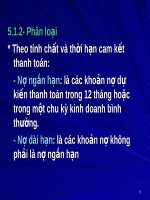Financial accounting chapter 10 liabilities kế toán nợ
Bạn đang xem bản rút gọn của tài liệu. Xem và tải ngay bản đầy đủ của tài liệu tại đây (1.05 MB, 50 trang )
10-1
Chapter 10
Liabilities – Kế Toán Nợ
Learning Objectives
After studying this chapter, you should be able to:
1. Explain a current liability, and identify the major types of current
liabilities.
2. Describe the accounting for notes payable.
3. Explain the accounting for other current liabilities.
4. Explain why bonds are issued, and identify the types of bonds.
5. Prepare the entries for the issuance of bonds and interest expense.
6. Describe the entries when bonds are redeemed.
7. Describe the accounting for long-term notes payable.
8. Identify the methods for the presentation and analysis of non-current
liabilities.
10-2
Current liability
A debt that the company expects to pay within one
year or the operating cycle, whichever is longer.
Most companies pay current liabilities by using current
assets.
LO 1 Explain a current liability, and identify the
major types of current liabilities.
Current liabilities include notes payable, accounts payable, unearned
revenues, and accrued liabilities such as taxes, salaries and wages, and
interest payable.
Current Liabilities
10-3
The time period for classifying a liability as current is one
year or the operating cycle, whichever is:
a. longer
b. shorter
c. probable
d. possible
Question
LO 1 Explain a current liability, and identify the
major types of current liabilities.
Current Liabilities
10-4
LO 2 Describe the accounting for notes payable.
Notes Payable
Recorded obligation in the form of written notes.
Usually require the borrower to pay interest.
Issued for varying periods of time.
Those due for payment within one year of the statement
of financial position date are usually classified as current
liabilities.
Current Liabilities
10-5
Illustration: Hong Kong National Bank agrees to lend
HK$100,000 on September 1, 2014, if C.W. Co. signs a
HK$100,000, 12%, four-month note maturing on January 1.
Instructions
a) Prepare the journal entry on September 1.
b) Prepare the adjusting journal entry on December 31,
assuming monthly adjusting entries have not been made.
c) Prepare the journal entry at maturity (January 1, 2015).
LO 2 Describe the accounting for notes payable.
Current Liabilities
10-6
Notes payable
100,000
Cash 100,000
Interest payable
4,000
Interest expense 4,000
HK$100,000 x 12% x 4/12 = HK$4,000
b) Prepare the adjusting journal entry on Dec. 31.
LO 2 Describe the accounting for notes payable.
Current Liabilities
Illustration: Hong Kong National Bank agrees to lend
HK$100,000 on September 1, 2014, if C.W. Co. signs a
HK$100,000, 12%, four-month note maturing on January 1.
a) Prepare the journal entry on September 1.
10-7
Interest payable 4,000
Notes payable 100,000
Cash
104,000
LO 2 Describe the accounting for notes payable.
Current Liabilities
Illustration: Hong Kong National Bank agrees to lend
HK$100,000 on September 1, 2014, if C.W. Co. signs a
HK$100,000, 12%, four-month note maturing on January 1.
c) Prepare the journal entry at maturity (January 1, 2015).
10-8
LO 3 Explain the accounting for other current liabilities.
Sales Tax Payable
Sales taxes are expressed as a stated percentage of
the sales price.
Either rung up separately or included in total receipts.
Retailer collects tax from the customer.
Retailer remits the collections to the government’s
department of revenue.
Current Liabilities
10-9
Illustration: The March 25 cash register reading for Cooley
Grocery shows sales of NT$10,000 and sales taxes of NT$600
(sales tax rate of 6%), the journal entry is:
Sales revenue
10,000
Cash 10,600
Sales tax payable
600
LO 3 Explain the accounting for other current liabilities.
Current Liabilities
10-10
LO 3 Explain the accounting for other current liabilities.
Unearned Revenue
Revenues that are received before the company delivers goods
or provides services.
1. Company debits Cash, and credits
a current liability account
(Unearned Revenue).
2. When the company earns the
revenue, it debits the
Unearned Revenue account,
and credits a Revenue account.
Current Liabilities
10-11
Illustration: Busan IPark (KOR) sells 10,000 season football
tickets at W 50,000 each for its five-game home schedule. The
club makes the following entry for the sale of season tickets (in
thousands of W):
LO 3 Explain the accounting for other current liabilities.
Unearned ticket revenue
500,000
Cash 500,000Aug. 6
Ticket revenue
100,000
Unearned ticket revenue 100,000Sept. 7
As each game is completed, Busan IPark records the revenue
earned.
Current Liabilities
10-12
Current Maturities of Long-Term Debt
Portion of long-term debt that comes due in the
current year.
Considered a current liability.
No adjusting journal entry required.
LO 3 Explain the accounting for other current liabilities.
Current Liabilities
10-13
Current liabilities are presented after non-current
liabilities on the statement of financial position.
A common method of presenting current liabilities is to
list them by order of magnitude, with the largest ones
first.
Presentation
Statement Presentation and Analysis
LO 3 Explain the accounting for other current liabilities.
10-14
Statement Presentation and Analysis
Illustration 10-3
LO 3 Explain the accounting for other current liabilities.
10-15
Liquidity refers to the
ability to pay maturing
obligations and meet
unexpected needs for
cash.
The current ratio
permits us to compare
the liquidity of different-
sized companies and of
a single company at
different times.
Illustration 10-5
Illustration 10-4
LO 3 Explain the accounting for other current liabilities.
Analysis
Statement Presentation and Analysis
10-16
A form of interest-bearing notes payable.
To obtain large amounts of long-term capital.
Three advantages over ordinary shares:
1. Shareholder control is not affected.
2. Tax savings result.
3. Earnings per share may be higher.
LO 4 Explain why bonds are issued, and identify the types of bonds.
Non-Current Liabilities
Bond Basics
Obligations that are expected to be paid after one year.
10-17
Effects on earnings per share—equity vs. debt.
Illustration 10-7
LO 4 Explain why bonds are issued, and identify the types of bonds.
Bond Basics
10-18
The major disadvantages resulting from the use of bonds
are:
a. that interest is not tax deductible and the principal
must be repaid.
b. that the principal is tax deductible and interest must
be paid.
c. that neither interest nor principal is tax deductible.
d. that interest must be paid and principal repaid.
Question
LO 4 Explain why bonds are issued, and identify the types of bonds.
Bond Basics
10-19
Types of Bonds
LO 4
Bond Basics
10-20
Government laws grant corporations power to issue
bonds.
Board of directors and shareholders must approve bond
issues.
Board of directors must stipulate number of bonds to be
authorized, total face value, and contractual interest rate.
Terms of the bond are set forth in a legal document
called a bond indenture.
Issuing company arranges for printing of bond
certificates.
Bond Basics
Issuing Procedures
LO 4 Explain why bonds are issued, and identify the types of bonds.
10-21
Represents a promise to pay:
►
face value at designated maturity date, plus
►
periodic interest at a contractual (stated) interest
rate on the maturity amount (face value).
Interest payments usually made semiannually.
Generally issued when the amount of capital needed is
too large for one lender to supply.
Bond Basics
Issuing Procedures
LO 4 Explain why bonds are issued, and identify the types of bonds.
10-22
Maturity
Date
Maturity
Date
Illustration 10-8
Contractual
Interest
Rate
Contractual
Interest
Rate
Face or
Par Value
Face or
Par Value
DUE 2017 DUE 2017
2017
LO 4
Issuer of
Bonds
Issuer of
Bonds
Bond Basics
10-23
Bond Trading
Bond Basics
Bondholders can sell their bonds, at any time, at the
current market price on national securities exchanges.
Bond prices are quoted as a percentage of the face value.
LO 4 Explain why bonds are issued, and identify the types of bonds.
Application
$952.50 $1,018.75
(2) What is the price of a $1,000 bond trading at 101 7/8?
Application
(1) What is the price of a $1,000 bond trading at 95 1/4?
10-24
Bond Trading
Bond Basics
Bondholders can sell their bonds, at any time, at the
current market price on national securities exchanges.
Bond prices are quoted as a percentage of the face value.
Newspapers and the financial press publish bond prices
and trading activity daily.
LO 4 Explain why bonds are issued, and identify the types of bonds.
Illustration 10-9
10-25
Bond Trading
Bond Basics
Bondholders can sell their bonds, at any time, at the
current market price on national securities exchanges.
Bond prices are quoted as a percentage of the face value.
Newspapers and the financial press publish bond prices
and trading activity daily.
A corporation makes journal entries only when it issues
or buys back bonds, or when bondholders exchange
convertible bonds into ordinary shares.
LO 4 Explain why bonds are issued, and identify the types of bonds.









